Written by Eva Everloo (Senior Analyst) together with Anđela Martinović, Ph.D. (Scientific Analyst), Anina Troya (Analyst Intern) & Orly Savion, Ph.D. (CTO)
PeakBridge
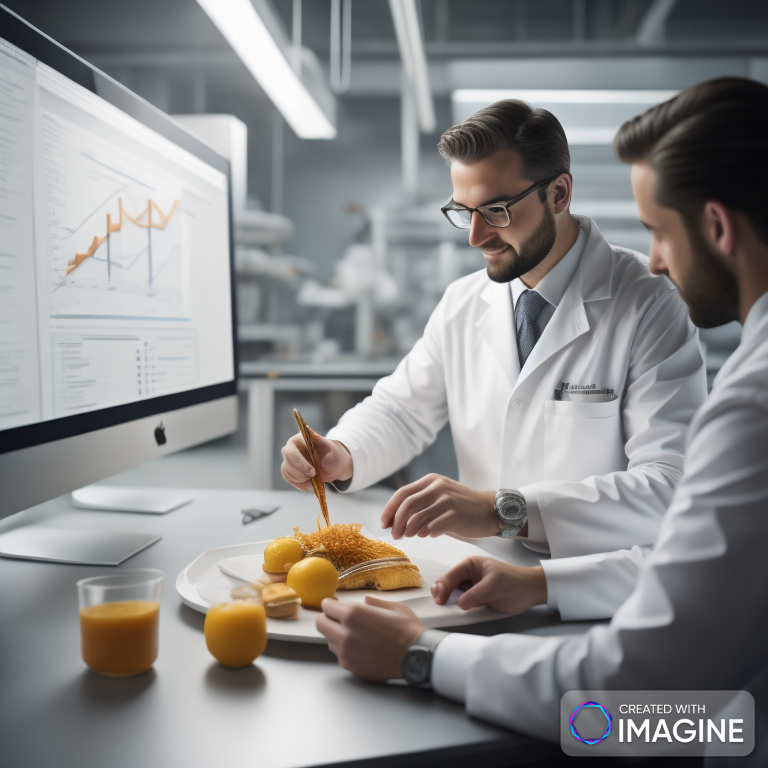
1. The Synergy of AI & Food: Revolutionizing an Industry
The journey of Artificial Intelligence (AI) commenced with Alan Turing’s visionary “Intelligent Machinery” in 1948, setting the stage for a 21st century explosion of breakthroughs in Machine Learning (ML) and in Neural Networks (NN) and paving the way for the integration of AI models across industries. Simultaneously, global food production has evolved.
The “Green Revolution” of the 1970s introduced high-yield crops and improved irrigation techniques. Although it aimed for food security, the intensified fertilizer use raised concerns about environmental sustainability. With the planet projected to host nearly 10 billion inhabitants, the urgency is evident. The rate of global meat consumption is rapidly increasing[i], but agricultural yields are not keeping up with demand projections. Add to this the imperative to slash emissions and land use, and we’re in need of a food production tech re-evolution. Explore the timeline in the “Further Reading” section of this article for a summary of milestones in food production, AI, and their convergence from 1950 to today.
Amidst these circumstances, venture capital investments in FoodTech have surged, aiming to accelerate the development of alternative foods and food production methods (Pitchbook data). While substantial advancements have been made in cellular agriculture (among others), the real challenge lies in scaling these innovations within a reasonable timeframe and at an affordable cost.
This is precisely where AI steps in, becoming a pivotal ally in food innovation that complements human intelligence. While still in its early stages of adoption in the food industry, AI is already optimizing supply chain operations, catalyzing product development, and creating nutritious, healthy, and sustainable food options tailored to consumer demand. Drawing a parallel, just as the widespread adoption of electricity coincided with the Industrial Revolution in the late 18th century that enabled the development of electrical infrastructure and led to a global shift in productivity[ii], AI is poised to spark its own revolution, fundamentally reshaping how we approach productivity in the food industry.
A closer examination of Pitchbook data from the 21st century shows that AI investments in the Agrifood sector reached $11.5 billion. To put this into perspective, the global food industry generates about $9.4 trillion in annual revenue[iii]. In contrast, the healthcare and pharmaceutical industries, with a yearly expenditure of around $8.3 trillion[iv], received nearly nine times more investment capital for AI innovations during the same timeframe, totaling $94.4 billion (see figure below).
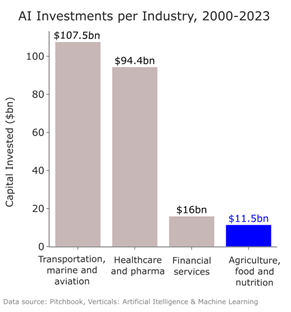
Pitchbook search parameters: Ownership: All, Years: 2000-2023, Retrieved: 04/09/2023. Food and nutrition companies originally placed in healthcare, consumer durables, IT, etc., were reclassified under the food category if they had industry verticals linked to AgTech, FoodTech, or Restaurant Tech.
Why Now?
In the face of mounting challenges, the food system is calling for the integration of AI solutions to pave the way for enhanced resilience and sustainability. This multi-volume deep dive begins with this article centered on new food product development, followed by two volumes that explore other pivotal areas within the food system, where the urgency for change and the potential for AI is high. Each volume unveils insights into AI applications, investments, challenges & opportunities, and the startup landscape. See the overview below for a breakdown of this deep dive series.
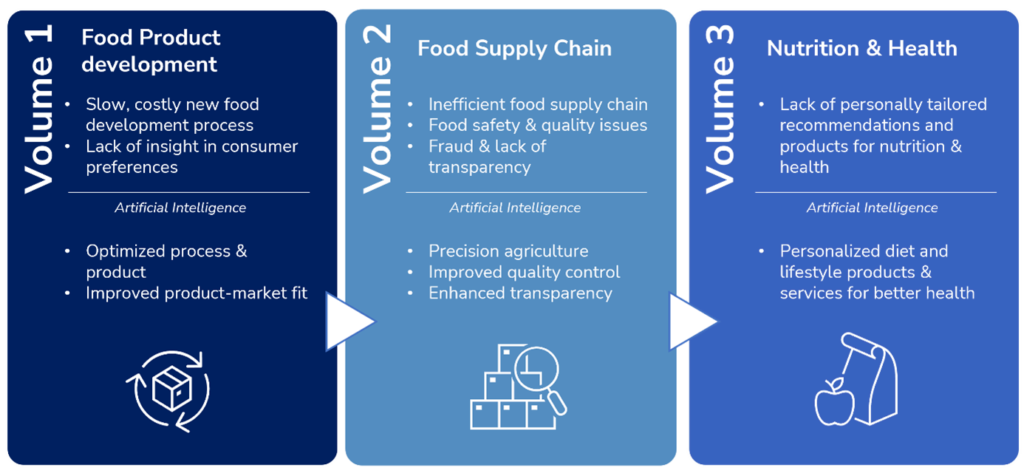
Apart from presenting an opportunity to solve complex challenges across the food system, AI is also changing the overall business landscape. Companies are responding to consumer trends and bringing products to market faster than ever (think fashion brand Shein that launches 6000 new items on its website every day[i]), and consumers are starting to expect this. To keep up with trends and succeed in their go to market strategies, food innovation must become fast-paced.
2. The Product Development Cycle of Food Corporates
The new product development cycle (see figure below) in food corporates, from bench to shelf, traditionally suffered from limited information and fragmented data. This complexity arises from distinct departments handling various facets of the cycle, including marketing, R&D and sales. These challenges result in slow decision-making and lengthy innovation cycles characterized by:
- Trial-and-error approaches
- High costs
- Reliance on time-consuming human panels
- Limited product-market fit
It therefore comes to no surprise that around 80% of food product launches fail[ii], primarily due to consumer rejection. AI addresses these challenges through reducing the need for extensive trials and fostering cross-departmental collaboration using robust data networks. It can streamline the entire process by optimizing product formulation, process parameters and market trend analysis.
“For me, the whole digitization agenda is so relevant and so exciting because, if done well, it should truly move things much faster. Avoid a lot of tests and trial and error approaches which a classical R&D organization still has and go into predictability at a much faster pace.”
Miriam Überall – FoodTech Expert and Former Executive R&D at Kraft Heinz and Unilever

Let’s now dive a bit deeper into how AI can accelerate the different parts of the product development cycle.
3. The Role of AI In Accelerating Innovation Cycles
Consumer Insights & Idea Generation
AI is reshaping new product development by leveraging a multi-faceted data-driven approach. Firstly, AI interprets real-time trends from external sources capturing information such as opinions and emotions. This involves analyzing social media, tracking keywords, using GenAI-powered chatbots for surveys, and AI’s image analysis for food preferences. AI also extends to IoT sensors, gathering consumer data on product choices and cooking preferences[iii]. Furthermore, ML conducts predictive analysis internally, leveraging historical sales data and market trends to accurately forecast consumer demand and preferences, optimizing new food product launch timings and adapting to market changes. This continuous data analysis uncovers consumer insights, fostering deeper engagement in a competitive, fast-changing food market.
PeakBridge’s portfolio company, Tastewise, is an example of a startup that is using AI to inspire new product development. The company has developed software that collects a vast amount of data from different sources (e.g., social media, reviews, menus, recipes) to understand evolving food trends and consumer tastes. This software is a valuable tool for food corporates as it helps them create consumer-desired and preferred products. See below an example of the company’s most recently launched tool, “Concept Discovery” by “TasteGPT”, that discovers AI-generated concepts and images based on top-rising consumer demand pairings. The prompts provided for these examples were “coffee variations” (top image) and “fun crazy food” (below image).


Two other companies working on consumer insights are Bite.ai and Gastrograph. bite.ai is a startup focused on food image recognition to improve food logging and generate data-driven customer insights. Gastrograph has created the “world’s largest sensory database”, helping food corporates align their products with the flavors, aromas and textures that are driving consumer demand.
Discovery Of New Ingredients
Moving along in the new product development cycle, AI can also accelerate the discovery of new food ingredients, improving the screening and characterization of molecules. Startups working on the intersection of ingredient discovery and AI engage food and data science experts to develop an effective algorithm that supports food discovery pipelines. Examples include GinkoBioworks and Arzeda, that use a combination of computational design and AI to create novel proteins and enzymes.Amai Proteins uses computational biophysics and AI to design novel proteins optimized for various functionality and taste traits. Finally, Brightseed supports novel ingredient development by identifying health-promoting bioactive compounds using their AI-powered platform Forager®.
R&D & Optimization
Lab Scale: Optimization of Functionality, Sensory & Nutrition
Further along in the product development cycle is the optimization of food matrix functionality —covering sensory and nutritional attributes. AI takes centre stage in predicting and enhancing these attributes for diverse food products. It suggests ingredient ratios to match taste profiles and offers healthier substitutions while preserving flavour. Additionally, AI, in conjunction with IoT sensors and imaging systems, assists in assessing food product texture, ensuring characteristics like chip crispiness or meat tenderness meet expectations. On the nutritional front, AI optimizes recipes to achieve specific goals, whether it’s reducing sugar content or increasing protein levels, and predicts the nutritional composition to align with labelling requirements.
Precision fermentation, that involves the manipulation of genetic material to produce proteins, is a good example of a recent food technology that is converging with data science. Gene-expression modelling, 3D protein configuration modelling, and simulations assist scientists in identifying genome changes that enhance the likelihood of generating specific proteins. Without AI, conducting these experiments could take centuries. Emerging in the late 2010s, startups like Shiru and PeakBridge’ portfolio company ImaginDairy are examples of this convergence of innovation.
“We can look at cells as small factories for generating proteins: cells evolved for billions of years to replicate themselves very efficiently; thus, using gene expression is the most efficient way to generate protein. This process includes the introduction of the gene encoding the target protein into the genome of a host cell such that it will be translated to the target proteins by the intracellular machinery of the cell. To make this process efficient and compete with the conventional food industry, we need to re-design the ‘factory’ (i.e., the host cell). This is done via introducing ‘smart’-model based mutations into the genomes of the host and cannot be done without sophisticated algorithms, models, and AI.”
Prof. Tamir Tuller – Co-founder at ImaginDairy
Scale-Up: Optimization of Yield & Cost
After developing food products at a laboratory scale, the subsequent phase in the cycle involves establishing machinery and production lines for large-scale manufacturing. The goal is to ensure cost competitiveness while maintaining the same nutritional and sensory attributes observed during lab-scale production. This can be achieved through the utilization of ML algorithms that predict a food’s physical and chemical properties (e.g., pH during cheese and cocoa fermentation[v]) and model processing conditions (e.g., antioxidant extraction or potato peel conditions).
Innovations in the cultivation of alternative proteins, such as lab-grown meat, exemplify AI’s role. Precise control over temperature, pH levels, nutrient supply, and growth factors is imperative in laboratory settings. Entrepreneurs and scientists face the challenge of upscaling manufacturing to meet the increasing demand for animal protein while minimizing the need to clear forests and wild vegetation for feed crops. AI offers a solution by analysing extensive data to identify optimal conditions for scaling up production. Pioneering startups such as Animal Alternative Technologies and Umami Bioworks are leading this field, developing intellectual property and scalable technologies with data science optimization. Another notable startup in this space is Eternal, which leverages AI and robotics to automate experimentation, analysis, and biomass fermentation optimization. These advancements are also set to benefit large producers of animal protein seeking viable and sustainable pathways for transitioning to large-scale alternative protein production.
Startup-Corporate Partnerships
Startups, as compared to food corporates, benefit from their smaller size, and often experience swifter information dissemination due to reduced compartmentalization. Nevertheless, constructing suitable data infrastructure remains a challenge, given their limited financial and human resources. This can impede the commercialization of novel products in an appropriate time span. Recognizing the value of startup advancements in fulfilling the demand for healthy, delicious, and sustainable foods, numerous food corporates are forging partnerships with startups. Examples include:
- In 2022, Kraft Heinz and NotCo established a joint venture that resulted in the launch of “NotMayo” in US retail stores. NotCo’s AI platform, Guiseppe, will support Kraft Heinz in developing reimagined products with plant-based ingredients[vi].
- In 2023, Bell Group announced their partnership with AI-powered Climax Foods to co-create plant-based versions of their renowned cheese products and brands, as part of the corporate’s efforts to reduce their carbon footprint[vii].
- ADM partnered with Brightseed, a bioactive ingredient company to leverage AI and decode the gut microbiome, aiming to launch the next generation of symbiotic products[viii].
- Unilever kickstarted a partnership with biotech microbiome expert company, Holobiome, to discover food ingredients targeting the gut brain axis[ix].
4. Startup Landscape – New Product Development Ecosystem
Since the late 2010s, we have witnessed a surge in startups dedicated to AI-driven food product development. Their expertise lies in providing AI-driven solutions for tasks such as market analysis, consumer insight forecasting, and predictive modeling for product and process parameters. In the figure below, various startups are shown, working on different parts of the NPD cycle. We can distinguish between two types of startups here. This differentiation highlights two distinct trajectories within the food industry’s adoption of AI.
- AI-Centric Service Startups: facilitate corporate product development by infusing AI across different stages of their innovation lifecycle.
- AI-Integrated Startups: use AI to enhance their own product development, introducing novel market offerings.
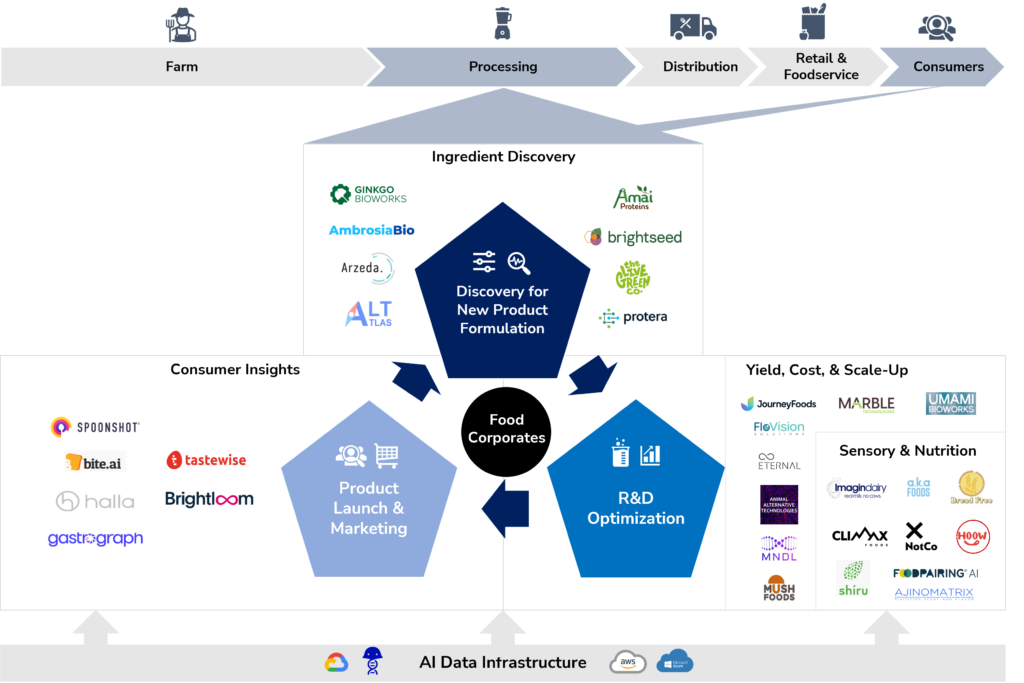
Disclaimer: this overview is not exhaustive and only represents a selection of startups. Furthermore, the categorization of companies is non-exclusive, meaning startups can fall under multiple categories.
5. Challenges For AI in Food
As previously explored, utilizing AI for new food product development offers a spectrum of advantages, including cost-efficiency, speed, customization, predictive capabilities, and data-derived insights. However, several challenges emerge in this landscape:
- Data Quality, Quantity, and Connectivity (“Garbage In, Garbage Out“): Achieving optimal algorithm performance relies heavily on abundant, high-quality data. The output is only as valuable as the input data. This requires investments in data generation for R&D teams and in proper data infrastructures and connected data systems between departments in food corporates. Once data infrastructure is established, effectively utilizing it furthermore involves understanding existing data, integrating it into an overarching data architecture, designing data strategies, and aligning with objectives. Here, data infrastructure providers such as Google, AWS, and Microsoft play an enabling role.
- Insufficient Processing Power: AI’s ability to handle extensive datasets is limited by processing power. Quantum computing holds the potential to address processing power limitations, with investments in infrastructure and research. Infrastructure companies like IBM, Google, and D-Wave are key players in advancing quantum computing for AI.
- Limited Historical Data: An emerging field such as FoodTech lacks historical data to feed algorithms, making it harder to generate meaningful results.If available at all, it is often found in many different and unstructured data formats. Developments are needed to make the input of relevant data more format agnostic.
- Costs of Implementation: Setting up and maintaining AI systems can be expensive, especially for small companies. Large corporates, on the other hand, have existing systems which might not be future-fit and therefore require significant investments to adapt.
- Liability and Ethical Considerations: The increasing complexity of AI systems, especially in predictive and prescriptive applications, raises questions of liability and responsibility, challenging the legal and ethical frameworks needed to address potential AI errors and consequences.Additionally, assessing AI’s impact on jobs and traditional food cultures is crucial to understanding its overall effects.
- Data Protection & Security: Protecting proprietary data, like secret recipes, while promoting data sharing to optimize AI applications is a complex challenge that requires effective governance mechanisms (“you cannot untrain an algorithm”). Also, protection against digital attacks is crucial.
- Regulatory Adaptation: Food laws change often. AI systems must keep up. Plus, regulations often require interpretation – AI might not be fit for this (for now).
- Multidisciplinary Collaboration & Skill Sharing: Combining AI and food expertise requires effective communication among experts from different fields (think of food scientists, engineers, and data scientists). There is a need for accelerated skill sharing and building across departments to make integrated data-driven decisions.
- Consumer Acceptance: Building trust in AI-produced food requires education to address concerns and fears of consumers.
- Environmental Impact: Beyond efficiency, AI’s effects on the environment need to be considered and compared to the environmental mitigation benefits.
Navigating these challenges is pivotal as the industry embraces AI’s potential while proactively addressing its limitations and societal implications.
Bottom Line – Paving the Path Ahead
In this article, we looked at the potent synergy between AI and FoodTech, a transformative nexus addressing escalating food demand and sustainability imperatives. From inspiration for new food product design driven by data on consumer demand, to newly suggested process parameters that can improve sensory attributes, yield and reduce costs, AI optimizes every step of a food corporate’s new product development cycle. In doing so, it has the opportunity to unite siloed departments and offer a new, data-driven directive that surpasses the traditional trial-and-error approach. Through AI, a novel paradigm emerges in new ingredient and product discovery, lab-scale innovation, large-scale manufacturing and in consumer engagement, enabling effective decision-making.
Agile startups merge with food corporates to accelerate this transition and thereby bridge the innovation gap – a trend that is expected to gain more momentum in the near future. Challenges in data quality, processing power and ethics emerge, yet AI’s promise of faster iterations and data-informed decisions penetrates the food industry. As we savour this harmonious interplay, AI guides FoodTech toward an appetizing tomorrow.
Stay tuned for Volume 2, where we dive deep into the potential of AI to address food safety, transparency and quality challenges (and more) across the food supply chain.
Further reading
- A brief history of key developments in Food Production & AI:
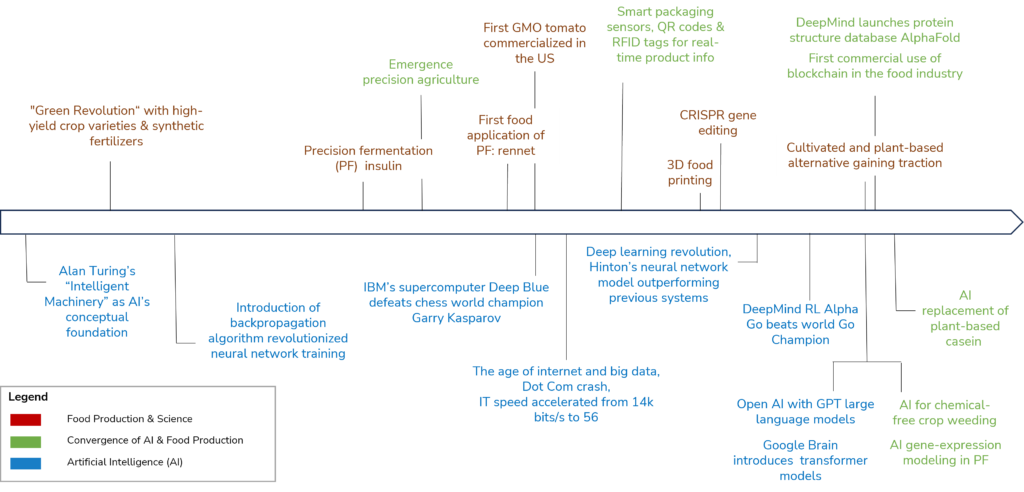
- The Fourth Industrial Revolution (book)
- IoT, big data and artificial intelligence in agriculture and food industry (article)
[i] https://www.dailymail.co.uk/femail/fashion/article-11756233/The-truth-worlds-fastest-fashion-brand.html
[ii] https://www.foodnavigator.com/Article/2019/03/18/Most-new-products-fail-Implicit-sensory-testing-can-help-beat-the-odds#:~:text=When%20you%20launch%20a%20new,and%2080%25%20of%20them%20fail.
[iii] https://ieeexplore.ieee.org/document/9103523
[iv] https://www.foodnavigator.com/Article/2023/07/25/How-Unilever-is-using-artificial-intelligence-and-big-data-biology-to-transform-food
[v] https://doi.org/10.1007/s12393-021-09290-z
[vi] https://www.fooddive.com/news/kraft-heinz-enters-joint-venture-with-notco/619224/
[vii] https://agfundernews.com/bel-group-invests-in-climax-foods-will-co-create-plant-based-cheeses#:~:text=Bel%20Group%E2%80%94the%20multinational%20firm,2024%2C%20starting%20with%20Mini%20Babybel.
[viii] https://www.nutritioninsight.com/news/adm-and-brightseed-partner-to-leverage-ai-to-decode-the-gut-microbiome.html
[ix] https://www.foodnavigator.com/Article/2023/07/25/How-Unilever-is-using-artificial-intelligence-and-big-data-biology-to-transform-food#
[i] https://ourworldindata.org/meat-production%23:~:text=As%2520a%2520global%2520average%252C%2520per,the%2520rate%2520of%2520population%2520growth.
[ii] https://www.google.nl/books/edition/The_Fourth_Industrial_Revolution/ST_FDAAAQBAJ?hl=en&gbpv=1&dq=the+fourth+industrial+revolution&printsec=frontcover
[iii] https://www.statista.com/outlook/cmo/food/worldwide#:~:text=Revenue%20in%20the%20Food%20market,(CAGR%202023%2D2028).
[iv] https://www.who.int/publications/i/item/9789240017788
